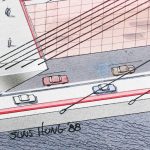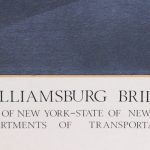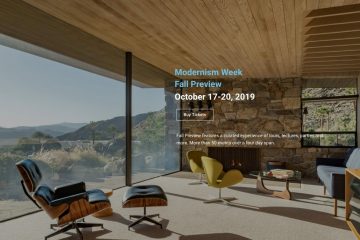Built in 1903, the Williamsburg Bridge was (at that time) the longest suspension bridge in the world. At the time of its opening, the Williamsburg Bridge was the first connection between the Lower East Side of Manhattan and Brooklyn. Boasting a total length of 7308 ft and a span of 1600 ft, this bridge was one of the last designed for the horse and carriage.
Adaptation and Disintegration
Chief Engineer Leffert Buck had originally designed the bridge so that traffic would adapt to it. However, it became clear within the first decade that the bridge needed to adapt to traffic.
Within the first ten years, engineers noticed that heavy traffic was causing the bridge to sag. To remedy this, they installed more steel to support the heavy subway cars and two supports were added under each of the unsuspended side spans.
Another issue that became evident as early as 1964 was the fact that Buck had not used galvanized steel to build the Williamsburg Bridge. Galvanizing metal allows it to oxidize without the formation of rust. Because of this decision, the bridge fell into disrepair, with reports of rust raining down on pedestrians.
Inspection and Rehabilitation
In 1988, it was discovered that there was massive corrosion of the steel cables, beams, and supports. This critical situation led the NYCDOT to debate whether to replace or repair the bridge. Replacing it would have cost $700 million, but the repair would only cost $250 million. Needless to say, they chose to repair the bridge, which brings us to the piece in our collection: The Williamsburg Bridge by architect Der Scutt.
“A Spectacular Landmark”
Der Scutt not only wanted the Williamsburg Bridge to be “a spectacular landmark”, but also planned to enhance the structure by covering the towers in “five-foot-by-seven-foot reflective panels with fine silicon joints, giving the appearance of a warm, cinnamon-colored reflective jewel in the East River, bringing a new elegance and new life to the surrounding areas in Manhattan and Brooklyn.” Now drivers could enjoy their travels and check their hair.
Not only would the bridge be covered in mirrors, but it would also boast 3 three towers, one of which would be a restaurant and another a museum. These establishments could be accessed by glass elevators. That would have been spectacular, indeed!
Not Meant to Be
Although Scutt’s design was not chosen as a Williamsburg Bridge replacement, it is a gorgeous piece to own. The drawing provides a fantastic story of the possibilities that could happen when rehabilitating landmarks.
About the Artist
Der Scutt, a modern architect, designed several of the most notable buildings in Manhattan. Although he passed away in 2010, his legacy lives on through his work in New York City. To own a piece of what could have been, visit our GALLERY.








